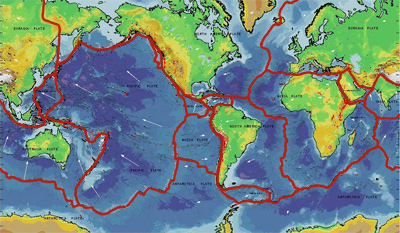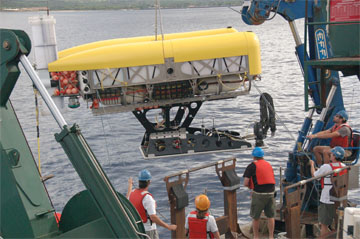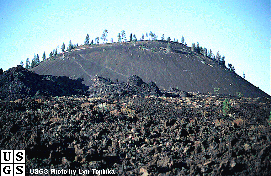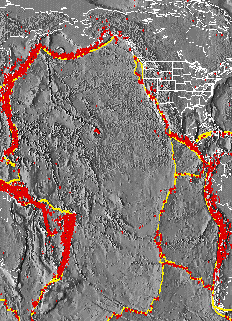This diagram shows evidence for seafloor spreading.
Click on image for full size
D. Roddy and LPI
Pacific Rim of Fire
The diagram shows a remarkable fact about the surface of the Earth. Around the rim of the Pacific Ocean are many volcanoes. The rim of the Pacific Ocean also is the scene of much earthquake activity.
These volcanoes are most typically found in the regions where subduction is taking place.
The ring of volcanoes around the Pacific Ocean is called the "Pacific Rim of Fire".
The diagram shown here also shows (in yellow) the boundaries of many of the Earth's surface plates.
You might also be interested in:

Many forces cause the surface of the Earth to change over time. However, the largest force that changes our planet's surface is the movement of Earth's outer layer through the process of plate tectonics.
...more
The Abyss is a dark, deep place, but it's no longer hidden. At least when Nereus is on the scene. Nereus is a new type of deep-sea robotic vehicle, called a hybrid remotely operated vehicle (HROV). Nereus
...more
Ash is made of millions of tiny fragments of rock and glass formed during a volcanic eruption. Volcanic ash particles are less than 2 mm in size and can be much smaller. Volcanic ash forms in several ways
...more
Cinder cones are simple volcanoes which have a bowl-shaped crater at the summit and rarely rise more than a thousand feet above their surroundings. They usually are created of eruptions from a single vent,
...more
Lava can move in broad flat lava flows, or it can move through constrictive channels or tubes. Lava flows have a large surface area so they tend to cool quickly and flow slowly. The fastest unconstricted
...more
Earth’s center, or core, is very hot, about 9000 degrees F. This heat causes molten rock deep within the mantle layer to move. Warm material rises, cools, and eventually sinks down. As the cool material
...more
Many kinds of surface features provide evidence of a sliding lithosphere. When two plates move apart, rising material from the mantle pushes the lithosphere aside. Two types of features can form when
...more















